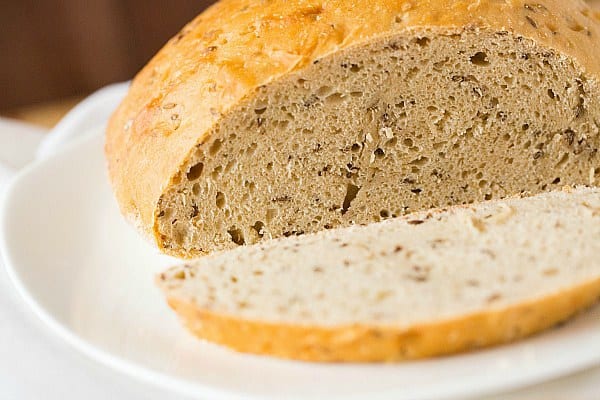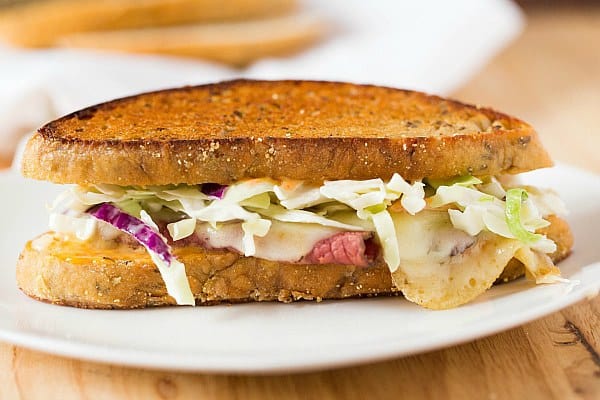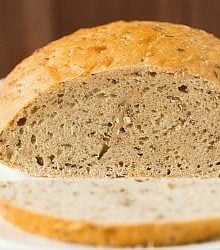Jewish Rye Bread

Yesterday, I walked you through how to make a rye sourdough starter, which means that today we talk about the actual bread! I don’t know about you, but for me, rye bread was absolutely an acquired taste. I remember being a kid and being totally befuddled by my great aunt’s fondness for rye bread. I didn’t quite share her affinity for the bread, and feel bad for any adult family member who had to deal with me if a stray caraway seed found its way into my mouth. The atrocity! You’d think that I had swallowed battery acid. (I was such a treat!)
It took me a long, long time to even want to try rye bread, and I was probably in my late twenties by the time I realized that I maybe, actually, sort of liked it. I’m sure that corned beef, Swiss cheese and Thousand Island dressing piled onto rye bread went a long way in swaying me to try it again. Once I realized it was actually quite good, I set about making my own. As I mentioned yesterday, I hit quite a few stumbling blocks on my way to this recipe, but I’m so elated to have finally conquered rye bread in my kitchen!

This version of sourdough rye bread is often referred to as “corn bread” because the word “corn” was used to describe any type of grain in Poland, Lithuania, Latvia and Russia, which are the areas where this bread originated. Can you believe that rye was first discovered in 500 A.D. and that dark rye bread was being eaten during the Middle Ages?! Talk about a classic!
This style of bread isn’t as light and fluffy as most commercial loaves of sandwich bread. Rather, it’s quite heavy and dense, and what I would consider moist (the recipe refers to it as “damp”). This means that each slice is substantial, which bodes well for a healthy slathering of butter on your morning toast.
Save This Recipe
It also makes an absolutely fantastic reuben sandwich.
(I’m a Pittsburgh girl, which means that I’ll always opt for coleslaw instead of sauerkraut on my sandwiches. See: Primanti Bros.)

Kitchen projects like this are what keep my baking heart ticking. The trial, the error, and then, finally, the fabulous feeling of something turning out just right. It’s a fun, satisfying experience… plus, there’s nothing more delicious than sweet kitchen success!

One year ago: New Orleans Beignets and Creole Shrimp and Grits
Two years ago: Blueberry Bagels
Three years ago: Oven-Fried Onion Rings with Dipping Sauce
Five years ago: Chicken and Dumplings

Jewish Rye Bread
Ingredients
- 1½ tablespoons (1.5 tablespoons) active dry yeast
- 1½ cups (375 ml) warm water, 110 degrees F
- 2 cups (250 g) first clear flour
- 1½ cups (153 g) rye flour
- 1½ cups (354 g) Rye Sour Starter
- 1½ tablespoons (1.5 tablespoons) salt
- 2½ tablespoons (2.5 tablespoons) caraway seeds, optional, use more or less if you'd like
Instructions
- In a large bowl, dissolve the yeast in the warm water. Let sit for 5 minutes, or until it starts to bubble and foam. Add the first clear flour, rye flour, rye sour starter, salt and caraway seeds. Stir with a wooden spoon until thoroughly incorporated.
- Turn the dough onto a well-floured work surface. Use a bowl scraper or dough cutter in one hand to help knead the soft, wet dough. Knead for 5 minutes by scraping, folding, pulling and stretching. The dough should have some elasticity and resist being stretched. Keep the dough soft, but if the dough does not feel elastic, add more first clear flour ¼ cup at a time, stretching and kneading with each addition. Continue kneading for another 3 minutes, keeping in mind that the wetter the dough, the better the bread. The amount of flour will vary depending on how stiff you made the rye sour starter.
- Transfer the dough to a clean, wet bowl. Keeping your hands wet, pat the dough down and cover with a very thin film of water. Cover the bowl with plastic wrap and place in a warm spot, allowing the dough to rise until it has doubled in volume, 45 to 60 minutes.
- Prepare a baking sheet sprinkled with a mixture of cornmeal and rye flour (this is where the bread will be baked).
- Wet a clean work surface with water. Keeping your hands wet, scoop out half of the dough and shape into a round, handling the dough gently so it doesn't tear. Repeat with the second half of the dough. Allow the dough to stand no longer than 10 minutes; it can be placed in the oven without any standing time, and should not be proofed.
- Place an empty broiler pan on the oven floor and preheat at 375 degrees F for 5 minutes.
- Brush the loaves with water. Place the baking sheet holding the bread on the middle rack of the oven, or on an oven stone if you have one. Carefully add 6 to 8 ice cubes or 1 cup hot water to the broiler pan on the bottom of the oven and immediately close the oven door (be careful, as it will steam immediately).
- Bake for 5 minutes, then remove the broiler pan. Slide the bread out and, with a skewer, make 10 to 12 holes all around the crust of each loaf, then return the bread to the oven. Reduce the heat to 350 degrees F and continue baking for 10 minutes, then make holes once more and brush again with water.
- Continue to bake until the crust is hard and unyielding to gentle pressure, which can take up to 1 hour or longer (mine took about 50 minutes). The timing will vary depending on the amount of moisture in the dough. The bread is done when tapping on the bottom with your fingertips results in a hollow sound and the top and sides are hard. If you have a stone, you can transfer the bread to the stone at this point and continue baking for an additional 10 to 15 minutes if you prefer crustier loaves.
- Remove the bread from the oven, brush the tops with more water and let cool on a wire rack. The bread will keep for up to 1 week wrapped in plastic wrap, and also freezes well.
Notes
- First clear flour is a high-protein, high-mineral wheat flour that is used by many bakeries for signature Jewish-style rye bread. I purchased mine from King Arthur Flour.
- A possible substitute for first clear flour is 1½ cups all-purpose flour and ⅓ cup cake flour, but the cookbook author notes that the result won't be quite as good.
- The book recommends using white rye flour, which I also purchased from King Arthur Flour.
Did you make this recipe?
Leave a review below, then snap a picture and tag @thebrowneyedbaker on Instagram so I can see it!





I will order the first clear flour from the KAF website – but my starter is ready and I am dying for some real rye bread! Is it possible to use Bread flour in its place?
Hi Jane, You could give it a try, but I can’t guarantee the results.
https://thesolitarycook.wordpress.com/2012/02/01/lets-bake-bagels-part-1/
This website says (again can not promise it will work) that you can substitute a bread flour and vital wheat gluten mix for first clear flour in a ration of 97% Bread flour to 3% VWG to create a 14.5% protein mix. I have not tried it but I hope this helps. True FCF is best but this might be a workable substitute.
As with far too many of my free-form loaves this one came out flat. Even though it rose like crazy there was not enough loft. It grew sideways.
I tried again – similar result. Maybe the starter is too wet, I don’t know. The bread spread out and made giant pancake like loaves, and took forever to cook through.
This is my second attempt. The crust turns out hard. I spray water on it instead of brushing but I can’t imagine that making a difference. What am I doing wrong? I’m fairly new to bread making. Any suggestions?
Hi Andria, Actually, spraying bread DOES create a hard, crisp crust. That’s the technique used when making Italian and French breads, which have characteristic hard crusts. Try brushing and see if that doesn’t help.
Where’d you find King Arthur first clear in the burgh? I had the darnedest time until I broke down and bought a sack of it from Stover Baking supply in Cheswick.
Hi Steve, Giant Eagle sells the five pound bags of KAF all-purpose, bread and white whole wheat. Maybe regular whole wheat, too? However, I order the 25-pound bag of all-purpose flour from King Arthur’s website. I’ve bought some stuff from that place in Cheswick – they have quite a bit!
I was wondering if maybe the salt was too much. You have listed 1 1/2 Tablespoons, should it be teaspoons?
No, this is the right amount of salt, rye bread needs quite some salt or it will taste too dull. (If it comes out too dull, just don’t bin it- eat it with salted butter instead).
I’ve seen some recipes with 1-2 teaspoons of pickle juice for extra tang? Good or bad idea?
I’ve heard of this as well and haven’t tried it, but you could certainly give it a go!
this will be a must try for me in the coming weeks. I have all that I need to make rye bread because it’s something I’ve wanted to try but just worried about the starter part. Now that I have your recipe, I WILL be giving it a try!
Rye bread has never been my favorite but I have grown quite fond of it as long as it doesn’t have seeds. This looks like it makes a mean sandwich!
This is so cool! I definitely didn’t like rye bread as a kid either…but I haven’t tried it in a long time, so I’m not sure what my feelings are now :) You really did make a beautiful loaf of bread, though, and that sandwich is mouth watering!
The last picture of that sandwich has my mouth watering! I just want to reach through the screen, grab half and take a big bite :) Kudos for conquering this bread!
PS – How insane was the Pit-Phil game tonight?! I was on the edge of my seat – too bad you guys didn’t come out with the win, but still a great game.
Ahhh, I was at the game! Total insanity. I’m way too emotionally invested in my sports teams, lol. By the time we walked out of the arena I had a sore throat, thought I might have a heart attack, and I’m still all amped up (yet exhausted) an hour after getting home ;-)
I absolutely love rye bread and cannot wait to try this! Thanks for sharing this great recipe!
lol milk and meat mixed on “JEWISH” rye too funny
Loved these last two posts! I’ve never made rye bread before but now I definitely want to. I adore rye bread and the incredible bakery by my house that had my favorite Jewish rye bread caught fire and burned to the ground. Devastating! For them as well as me and my rye bread fix. What better time to try making my own? Thanks for the great recipe!
Your rye bread looks perfect. Seriously… flawless. It also sounds perfect for St. Patricks Day in a few weeks. There is nothing like a good corned beef sandwich on rye bread.
I’m the same way! There are tons of things I’d refuse to eat when I was little that now I either like or have been more open to trying them out!
Wow, this rye makes one mouthwatering looking sandwich – it’s perfect!
My hubby and I love rye bread! Can’t wait to try making it at home :)
Looks like the perfect Crumb!
Oooooh! My mom always made us Reubens for Saint Patrick’s Day, and now I think I’m going to need to do the same thing. Excited to try this recipe!
It looks amazing, thanks for sharing :)
Wow! Turned out sooo great! It looks absolutely perfect. Saving this project for a rainy day. :)
Brava!! That is a beautiful loaf – thanks so much for sharing! I LOVE rye bread. Funny stuff abt the seeds – that’s how my son is now. lol
I’m trying this as I type, the starter is made and waiting for it to bubble and ferment, how long exactly does it take before I start to see something? I live in Geneva Switzerland and am going crazy for the taste of a good Jewish rye with caraway seeds so I can make a decent pastrami on rye. I’m having a tough time finding all the ingredients, is the cornmeal really necessary or can I just use the rye flour on the baking pan? I cannot find the flour you use, can regular bread flour be substituted? IF (lol) the starter turns out well I’m going to France this weekend to try and find a German 1050 flour or a French 110 that is supposed to be similar but in 4 years I have never seen cornmeal at the Carrefour in France or in the Coop or Migros in Geneva.
Hi Tonia, I can’t tell you when exactly the first part of the starter begins to bubble and ferment; since you could leave it for 24 hours, I mixed it early on a day when I was going to be gone all day and left it until the next morning, so I didn’t closely monitor its progress. The cornmeal is not necessary; you can just use the flour. I’m not sure how well bread flour would work in place of the rye.
I live outside the US too, and use regular polenta instead of cornmeal when I cant find it. Works great.
I’ve been waiting for this recipe! Rye breads is always a hit in my house! I love it toasted with melted butter! Yum!!
Oh, that bread. Oh, that sandwich. YUM.
I’m a Chicago girl so good bread is every where, but that coleslaw. Is the best!
*resists urge to buy rye flour* I’m supposed to be DE-pantrifying my apartment! Not ADDING to my pantry! LOL
I love rye bread and rye toast is my favorite breakfast. I’ll be trying your recipe asap!
I recently bought a sourdough starter from King Arthur flour and have only used it once. I’m not a fan but my husband and kids love it. I’m making all my bread these days so I really want to make it happen. Ever fooled around with a real sourdough, ie no yeast at all?
Hi Barbara, I haven’t, but that’s next on my list!
Wow, you nailed it! The best looking homemade rye bread ever! And it is absolutely an acquired taste but once you get into it, it’s like…where has this been all my life!
It was years for me before I realized that it was the caraway seeds that stuck in my teeth that I disliked about rye bread. The bread itself, even with some ground caraway in it is terrific! I can’t wait to try this!